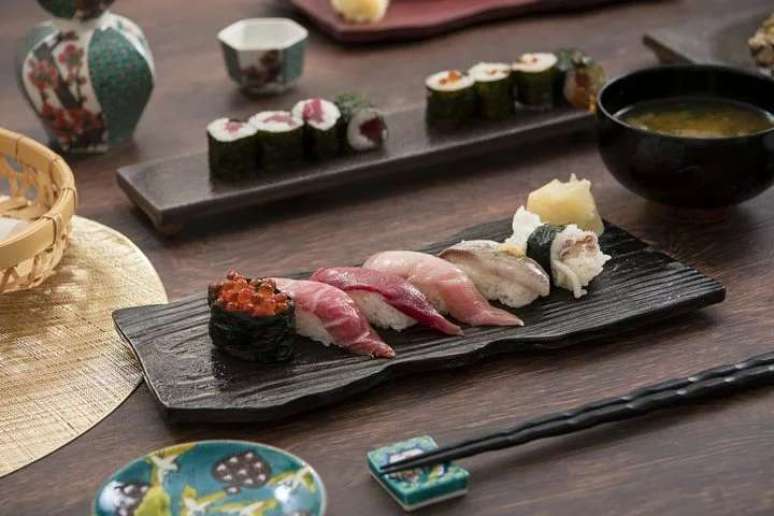-
Also known as “Washoku”, Japanese cuisine is loved around the world for its delicate flavors, fresh ingredients and focus on healthy eating.
Photo: wikimedia commons MUSUBI OVEN / Flip
-
Recognized by UNESCO as an intangible cultural heritage of humanity, Japanese cuisine offers a variety of nutritious dishes with surprising flavors. Discover the main Japanese dishes now, including drinks, desserts and soups!
Photo: Thomas Marban Unsplash / Flipar
-
Sushi: Rice cake seasoned with vinegar and filled with raw fish, seafood or other ingredients. It can be rolled in seaweed (maki) or shaped by hand (niguiri).
Photo: Kevin Petit of Pixabay / Flipar
-
Temaki: Seaweed cone filled with rice, raw fish, vegetables and other ingredients. A practical and tasty solution for eating with your hands
Photo: YouTube / Flipar playback
-
Donburi: Rice bowl with various side dishes such as meat, chicken, seafood, vegetables and eggs. A complete and nutritious meal.
Photo: Xavier Chng Unsplash / Flipar
-
Onigiri: rice cake filled with different ingredients, such as salmon, tuna, umeboshi or furikake. A practical solution for snacks or quick meals.
Photo: Youtube/ Sushi Com A Fê / Flipar
-
Sashimi: While not technically a dish, sashimi refers to thin slices of raw fish served with soy sauce and wasabi. It is a delicacy appreciated for its simplicity and the quality of the ingredients.
Photo: PublicDomainPictures by Pixabay / Flipar
-
Tempura: Seafood, vegetables or meat is coated in a light, crispy batter and fried until golden brown. Tempura is often served with tempura sauce or lime salt.
Photo: bady abbas Unsplash / Flipar
-
Ramen: A soup consisting of broth (usually pork or chicken), noodles, sliced pork, scallions, bamboo shoots, and a hard-boiled egg. There are several regional variations of ramen in Japan.
Photo: public domain – Wikimédia Commons / Flipar
-
Udon and Soba: Udon are thick, wheat-based noodles, served hot or cold with broth and various side dishes. Soba is a thin pasta made from buckwheat, also served hot or cold, often accompanied by soy sauce.
Photo: Masaaki Komori Unsplash / Flipar
-
Okonomiyaki: A type of Japanese pancake made with a dough of flour and water, combined with cabbage and other ingredients such as meat, seafood or cheese. It is cooked on a griddle and usually served with okonomiyaki sauce, mayonnaise and dried bonito flakes.
Photo: Guillaume Coué Unsplash / Flipar
-
Yakitori: Grilled chicken skewers, usually seasoned with tare sauce (made from soy sauce, mirin and sake). Yakitoris can include different parts of the chicken, such as breast, wings or thighs.
Photo: Magic Mary Unsplash / Flipar
-
Gyoza: Japanese pastries filled with minced meat and vegetables, seasoned with garlic, ginger and soy sauce. They are steamed and then fried until crispy.
Photo: REEET JANK Unsplash / Flipar
-
Miso shiru: miso soup with tofu, seaweed and other ingredients. A traditional Japanese soup, rich in proteins and nutrients.
Photo: Seiya Maeda Unsplash / Flipar
-
Edamame: Soybeans cooked in salted water. A light and healthy option, perfect for snacks or side dishes.
Photo: flickr Studio Sarah Lou / Flipar
-
Sunomono: cucumber salad with rice vinegar and sesame. A light and refreshing salad, perfect to accompany first courses.
Photo: flickr Vegan Party Catering / Flipar
-
Mochi: Glutinous rice cake filled with different flavors, such as red bean, sesame or chocolate. A traditional Japanese dessert, soft and tasty.
Photo: Minh Anh Nguyen Unsplash / Flipar
-
Dorayaki: pancake stuffed with red bean paste. A popular Japanese dessert, light and tasty.
Photo: wikimedia commons Ocdp/Flipar
-
Dango: glutinous rice balls skewered on a stick. They can be served with different flavors, such as strawberry jam, kinako (toasted soybean meal) or green tea.
Photo: Marek Piwnicki Unsplash / Flipar
-
Sake: Fermented alcoholic beverage made from rice. A traditional Japanese drink, with different varieties and flavors.
Photo: Zaji Kanamajina Unsplash / Flipar
-
Matcha: Green tea powder mixed with hot water. A traditional Japanese drink, rich in antioxidants and with a unique flavour.
Photo: flickr mike / Flipar
-
Ramune: Japanese non-alcoholic drink with a citrus flavor. A refreshing and popular drink in Japan.
Photo: Joshua Olsen Unsplash / Flipar
-
Overall, Japanese cuisine is high in nutrients and low in calories and saturated fat. Regular consumption of raw fish provides omega-3, which is important for cardiovascular and brain health.
Photo: Image by Design and Print by Pixabay / Flipar
-
Fresh vegetables provide vitamins, minerals and fiber, essential for good health. Soy, in turn, is rich in protein and isoflavones, which may help prevent heart disease and some types of cancer.
Photo: Orkun Orcan Unsplash / Flipar
-
Japanese cuisine is a great option for those looking for a healthy diet. It’s interesting to try new dishes, explore fresh ingredients and discover the nutritional benefits this rich culture offers.
Photo: Louis Hansel Unsplash / Flipar
Share
Source: Terra
Ben Stock is a lifestyle journalist and author at Gossipify. He writes about topics such as health, wellness, travel, food and home decor. He provides practical advice and inspiration to improve well-being, keeps readers up to date with latest lifestyle news and trends, known for his engaging writing style, in-depth analysis and unique perspectives.









